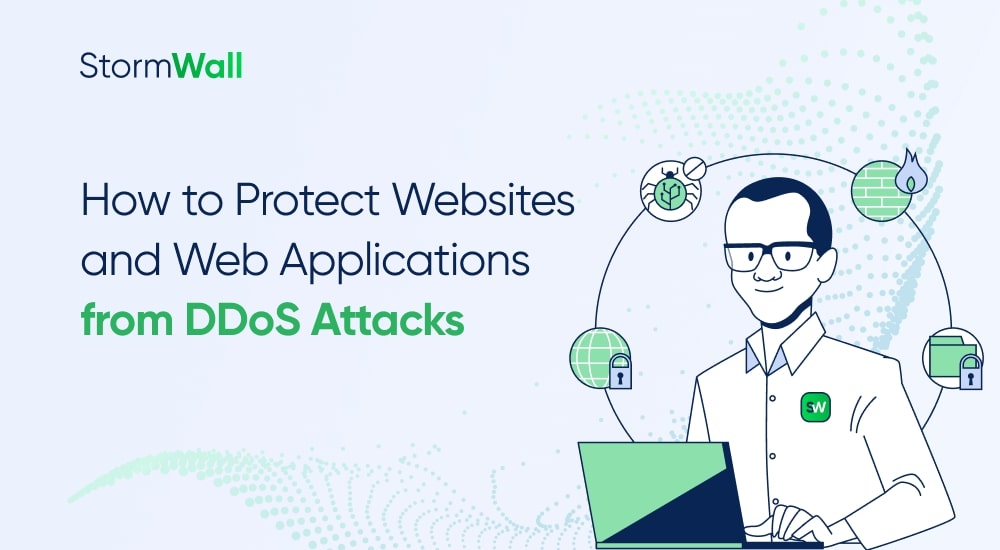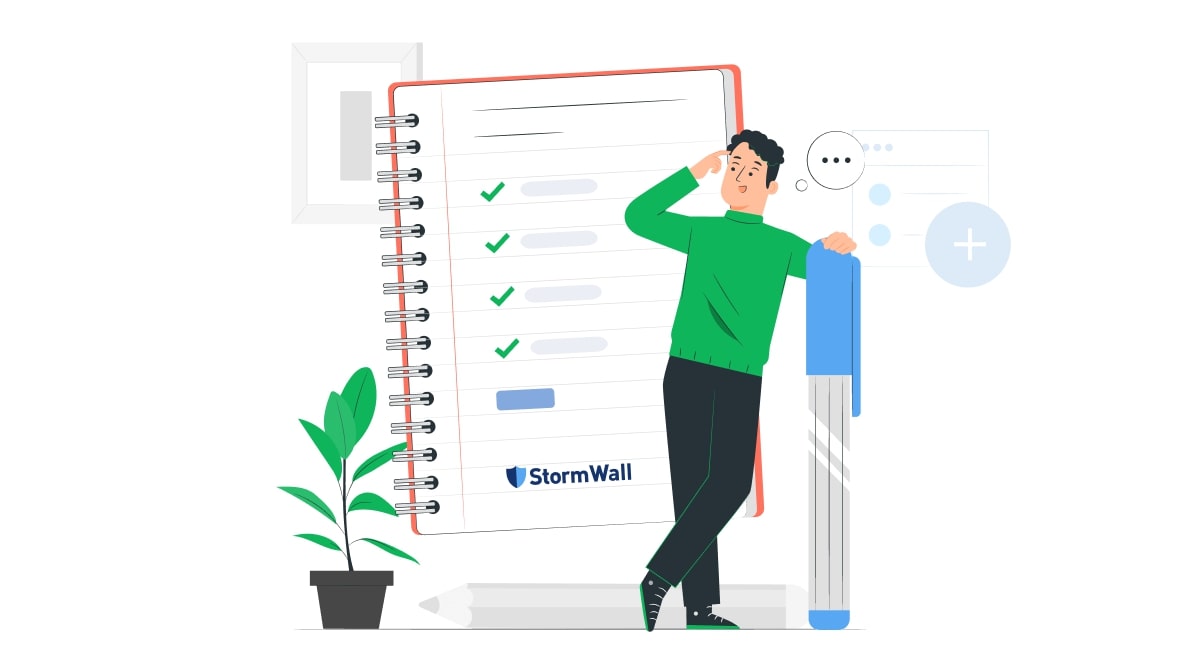Do not expect that by connecting even the best DDoS protection service in the world, you can protect your website from DDoS 100%. And this is not about the shortcomings of the services, but about the fact that different Internet resources have different resistance to DDoS attacks, and bringing them to the same level may require different efforts, means, and deadlines.

In 2017, our company proposed to use the concept of protectability as a characteristic of DDoS resistance. We would like to briefly point out that by protectability we mean the property of Internet resources to be reliably protected from DDoS attacks with minimal expenditure of money, time and effort.
In this article, we’ll explore how to protect your website from DDoS attacks, including best practices for securing websites, browser-based server components, mobile applications, and services that communicate via HTTP/HTTPS APIs.
The Challenges of Protecting Websites from DDoS Attacks
Modern websites are complex, multi-component applications that serve a variety of users and devices—browsers from different developers, mobile apps, and other online services that interact via HTTP requests and APIs. Unlike a decade ago, today’s web applications rely on advanced technologies like AJAX, APIs, and BFF (Backend-for-Frontend) to deliver seamless experiences.
However, this architectural complexity comes with a downside: greater vulnerability to cyber threats, including DDoS attacks. Websites must be protected across multiple layers of the OSI model, including the Network (L3), Transport (L4), and Application (L7) layers.
In recent years, “smart” application-layer attacks have become increasingly common. Unlike traditional DDoS attacks, these target not just HTTP/HTTPS protocols but the way server components interact with client-side modules and other systems—such as databases (DBMS) or data buses. Attackers exploit weaknesses in these interactions to disrupt operations in ways standard defenses might not detect.
Effectively protecting web applications requires deep expertise. That’s why choosing an anti-DDoS provider should be done carefully—prioritizing quality over cost, as cheap solutions often fail to provide reliable, long-term protection. If you’re wondering how to prevent DDoS attacks on your website, working with a professional anti-DDoS provider is a crucial first step.
Step 1. What to Do in the Design Phase of an Internet Application
Mistakes made early in a product’s lifecycle are often the hardest and most expensive to fix. This is especially true for security vulnerabilities—fixing them in a commercially deployed application can cost significantly more than addressing them during the design phase. That’s why security experts strongly recommend developing websites and internet applications in close collaboration with cybersecurity specialists—this not only strengthens security but also saves time and money in the long run.
Many common DDoS vulnerabilities originate in the design phase of an application. Some developers configure applications to access external internet resources directly via hardcoded IP addresses rather than using DNS resolution. This may seem like a simple shortcut, but it creates serious problems during a DDoS attack. Changing a hardcoded IP later can be extremely difficult, and protecting your website from DDoS attacks requires additional efforts and costs, which an anti-DDoS provider may not always be able (or willing) to accommodate.
Some applications use HTTP, but handle it in an unconventional way—following the protocol for some operations while ignoring it for others. This inconsistency makes it extremely difficult for an anti-DDoS provider to determine which traffic is legitimate and which is malicious. It’s far easier to address this issue before an attack happens rather than trying to fix it in the middle of a DDoS incident, when immediate protection is needed.
For effective DDoS mitigation, an anti-DDoS provider needs well-defined packet filtering rules to distinguish between legitimate requests and attack traffic. Without these rules, identifying and blocking attacks becomes significantly harder.
Some poor design choices make applications more susceptible to DDoS attacks. High interdependence between components means that if one service fails due to an attack, others become unstable or completely unavailable, leading to system-wide issues and user confusion. If a critical component is under attack, alternative access routes (e.g., different IPs from separate subnets) or partial functionality duplication should be in place.
A well-designed application should be structurally resilient to DDoS attacks. By minimizing interdependence between components, using DNS instead of hardcoded IPs, following standard HTTP protocols consistently, defining clear packet filtering rules, and implementing fallback mechanisms, developers can create applications that continue functioning even under attack, reducing downtime, costs, and security risks.

StormWall for Web:
DDoS Protection for Web Applications
Step 2. Audit Application Security, Assess DDoS Risks, and Plan Ahead
Before investing in anti-DDoS services, it’s essential to have a clear understanding of your application’s architecture, including all components and resources, which ones require protection, and the type and level of security they need. A comprehensive security assessment will help define precise protection requirements and ensure full coverage.
Comprehensive protection is crucial, as partial DDoS protection leaves vulnerabilities that attackers can exploit by targeting unprotected components. To prevent these gaps, your security strategy must cover all potential attack layers: Network (L3), Transport (L4), and Application (L7).
For effective defense against DDoS attacks, it’s important to use specialized security services that go beyond basic anti-DDoS measures. This includes Web Application Firewalls (WAFs), which help mitigate sophisticated application-layer attacks. However, WAFs alone are not enough to withstand high-intensity DDoS attacks, so a combined WAF and anti-DDoS solution is the best approach. If you’re looking for how to protect my website from DDoS attacks, using a combination of technologies is highly recommended.
To build a structured DDoS protection strategy, it’s recommended to develop a security roadmap that outlines connectivity and deployment plans in the early stages of application development. A mid-term strategy should also be in place to align with your application’s growth, evolving DDoS threats, and the changing risk landscape.
Since protecting your website from DDoS attacks is a critical aspect of cybersecurity, it’s essential to integrate it into your organization’s overall security strategy, ensuring continuous improvement and long-term resilience against cyber threats.
Step 3. Do You Need to Keep It Private?
If your internet application handles financial transactions (e.g., online banking or payments requiring PCI-DSS compliance) or processes personal data, you should consider DDoS protection without exposing SSL private keys.
By default, most organizations opt for protection with SSL key disclosure, as it offers greater flexibility in verifying application clients (e.g., tracking access from specific browsers or mobile apps). However, when secure financial or confidential data exchange is involved, keeping private keys undisclosed provides stronger data protection.
Many organizations have a mix of resources requiring different levels of security. In such cases, it’s best to use keyless protection for sensitive data while keeping standard protection with SSL key disclosure for less critical resources—this approach is more efficient and works seamlessly with a single request.
A hybrid approach can also be used, where a dedicated certificate-key pair is created specifically for DDoS protection. For example, StormWall can automate this process using Let’s Encrypt, allowing you to hide your real private key while still benefiting from protection with key disclosure.
Step 4. Provide Your Anti-DDoS Provider with Clear Filtering Guidelines
For an anti-DDoS provider to accurately differentiate between legitimate and attack traffic, they need clear filtering rules. This ensures that valid requests are not mistakenly blocked while malicious traffic is effectively filtered out.
Ideally, these filtering mechanisms should be defined during the application design phase. Developers should have a clear understanding of how to identify legitimate client requests and reject malicious ones, and these rules should be thoroughly documented for the anti-DDoS provider.
If your application is already live, it’s crucial to work closely with your security provider to clarify how your application functions so they can fine-tune traffic filtering accordingly.
DDoS protection for applications using non-standard interaction methods—such as mobile apps and software clients accessing via APIs—typically follows a two-step process:
1️. The anti-DDoS service’s machine learning system analyzes your application’s traffic, identifying key details like:
- The geography of legitimate requests
- Header signatures and interaction patterns
- The dynamics and intensity of requests
2️. Based on this analysis, the system builds a model of normal activity. Future requests are then compared against this model—matching requests are allowed, while suspicious ones are blocked.
The effectiveness of this approach depends on the ability to distinguish real users from bots. The provider assumes that malicious requests come from automated scripts and should be blocked.
However, if your application lacks a way to uniquely identify legitimate clients, the provider may have to rely on less precise indicators, such as:
- Unusually high activity from certain user groups
- Presence of IP addresses in known threat databases
This can severely limit the provider’s ability to detect sophisticated attacks. Advanced bots can overwhelm your application not by flooding it with simple requests, but by forcing it to generate heavy responses—draining server performance and bandwidth without directly triggering traditional DDoS defenses.
By defining clear traffic filtering rules and ensuring your application can uniquely identify legitimate users, you enable your anti-DDoS provider to offer stronger and more precise protection.
Step 5. Prepare Key Information for Your Anti-DDoS Provider
Based on the information gathered during the Internet application audit and the audit of its information security, it is necessary to prepare information for the anti-DDoS protection service provider that will help them build reliable and effective website protection from DDoS attacks.
Start by providing a list of locations from which non-browser clients access your application. This includes mobile apps, services using APIs, AJAX interactions, and other automated connections. With this data, your provider can properly configure traffic verification and prevent legitimate requests from being mistakenly blocked.
It’s also valuable to share detailed descriptions of your application architecture, including:
- The protocols used
- How components interact
- Integrations with external systems
These details enable the provider to distinguish between legitimate traffic generated by application components and malicious requests.
For applications accessed via mobile apps or legitimate bots, the provider should also know:
- User agents they use
- Request types and headers
- Legitimate request sources
- Expected request frequency per IP during normal activity
This level of detail allows for more precise filtering, ensuring real traffic is allowed through while blocking harmful activity.
If your anti-DDoS provider actively asks for such details, it’s a good sign of professionalism. Many providers simply connect their protection services without fine-tuning their defenses—leaving gaps that attackers can exploit. A provider that customizes protection based on your application’s specifics is far more likely to deliver strong and reliable DDoS mitigation.
Step 6. Minimize Exposure of Your Application to Attackers
A determined and skilled attacker will always look for ways to launch a successful attack, so it’s crucial not only to eliminate vulnerabilities but also to conceal whether their attack was successful. If attackers can gather enough information about your application, they can turn it into an entry point for future attacks.
One of the biggest risks is exposing your application’s real IP address. If an attacker discovers this, they can bypass anti-DDoS protections—simply changing the IP address, which is standard when enabling DDoS mitigation services, won’t be enough. IP addresses of online resources are easy to track, as numerous tools allow attackers to:
- View the entire IP history of a domain through public DNS records
- Extract a list of all IPs linked to a domain
- Find IPs through SMTP email headers, which your application likely uses
- Identify server hostnames in SSH banners, matching them to website domains
Ideally, your real server IP should remain completely hidden—it should not be visible in email headers, open ports, or any external services. By keeping this information concealed, you significantly reduce the risk of direct attacks and make it much harder for attackers to exploit your application’s infrastructure.
Step 7. Disable Unused Services and Close Unneeded Ports
When assessing the security of your internet application, it’s crucial to identify which services and ports are actually in use—and close any that aren’t. Leaving unused services open creates potential attack vectors that could be exploited unexpectedly, catching both you and your anti-DDoS provider off guard.
Once DDoS protection is enabled, it’s equally important to restrict access to your website exclusively through the IP address provided by your anti-DDoS provider. Proper firewall configuration should block all other IP addresses, ensuring that attackers cannot bypass the protection layer and directly target your infrastructure.
Step 8. Optimize Server Components for Better DDoS Resilience
Optimizing your server components is essential to ensuring your internet application can withstand weak DDoS attacks. No DDoS protection service can guarantee 100% filtering of malicious traffic, meaning that some attack packets may still get through. While a small percentage of leaked traffic might not seem critical, in the case of a high-volume attack (e.g., tens of gigabits per second), even 1% of the attack traffic could be enough to disrupt your application. To prevent this, both the server components and the underlying infrastructure must be optimized for high performance.
The specific optimization steps depend on whether you have direct control over the server where the application is hosted.
If you have full access and control, focus on:
- Optimizing the operating system’s network stack to improve request-handling capacity
- Tuning web server and CMS performance settings to maximize efficiency
- Enhancing database (DBMS) performance if your application relies on dynamic data retrieval
If your application is hosted on a third-party server or public cloud, work with your hosting or cloud provider to explore optimization options. You may need to:
- Upgrade to more powerful hardware
- Scale up to virtual machines with increased resources
These measures will not only increase your application’s resilience against weak DDoS attacks but also help manage peak loads more effectively.
Step 9. Use Protected DNS Services
When building DDoS protection, you must account for DNS-based attacks, as a successful DNS attack can make your application completely inaccessible or cause severe instability for users. It’s essential to verify whether the DNS services your application relies on are protected against DDoS attacks and assess their reliability and capacity.
To enhance DNS resilience, we recommend using at least two DNS providers, ensuring that at least one of them is protected from DDoS attacks at all levels (L3/L4 and L7). These protected DNS services can be obtained from both anti-DDoS providers and specialized DNS service providers. One provider can serve as the primary DNS service, while the other acts as a backup for redundancy.
For reference, StormWall offers advanced filtering solutions to protect DNS traffic at the application layer, ensuring stable and secure DNS resolution under attack conditions.
Step 10. Regularly Test Your DDoS Protection
Performing regular stress tests is essential to verify the effectiveness of your DDoS protection. Attackers are continuously improving their botnets, attack methods, and tools, making DDoS attacks stronger and more sophisticated every year. At the same time, your applications evolve, with regular updates and changes that may introduce new vulnerabilities.
Stress testing helps assess your application’s resilience to low-intensity DDoS attacks and simulates its behavior under real attack conditions. However, these tests should not be just a formality—they need to be thorough and carefully planned to cover:
- All externally accessible components
- All connected services
Comprehensive testing ensures that bottlenecks and vulnerabilities are identified and addressed before attackers can exploit them.
Read also: Why Stress Tests and Other DDoS Protection Checks Are So Important >>
Additionally, stress tests should be conducted on different days and times, not just during regular business hours. Testing on weekends, holidays, or just before public holidays is particularly useful, as anti-DDoS provider support teams may be less prepared for a sudden attack.
It’s also a great opportunity to evaluate how well your provider’s support team responds to attack reports. For instance, StormWall’s technical support team proactively reaches out to resource owners if a protected service becomes unavailable, regardless of whether a DDoS attack is detected at that moment or not.
Step 11. Establish a Continuous DDoS Protection Process for Your Website
DDoS protection should not be a one-time event—it must be an ongoing process that is deeply integrated with your overall cybersecurity strategy.
Since both external threats and applications are constantly evolving, protection efforts must be systematic. This includes regular security checks, meetings with your anti-DDoS provider, and comprehensive audits of both applications and their security measures. Maintaining effective long-term protection requires collaboration between your internal security team, your anti-DDoS provider, and, if applicable, your cloud or hosting provider.
DDoS protection should also be closely integrated with other cybersecurity processes, such as:
- Continuous monitoring and auditing
- Vulnerability management
- Configuration and incident management
Since DDoS risks are not decreasing, businesses must be prepared for long-term, proactive protection efforts to keep their websites secure and resilient.

How to Protect Your Website from DDoS Attacks: Final Checklist
- Lay the foundation for security in the design phase
- Conduct an application security audit, assess the need for DDoS protection, and plan its development
- Determine whether protection without disclosing private SSL keys is required
- Provide your anti-DDoS provider with clear filtering rules
- Prepare essential network and security details for your anti-DDoS provider
- Conceal as much information as possible about your application from attackers
- Disable unused services and close unnecessary ports
- Optimize server components for better resilience
- Use protected DNS services
- Regularly test your DDoS protection
- Establish continuous DDoS protection processes
By following this checklist, you can strengthen your website’s defenses, minimize vulnerabilities, and ensure long-term protection against DDoS threats.

DDoS Protection for Websites
- Activate protection in 10 minutes
- 24/7 technical support




















